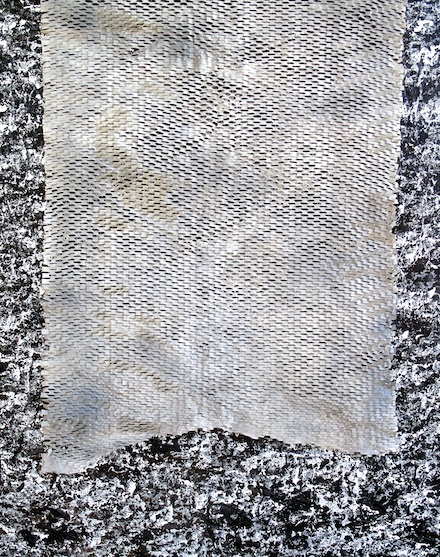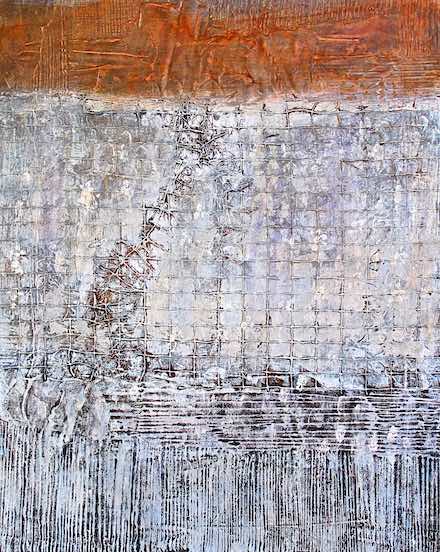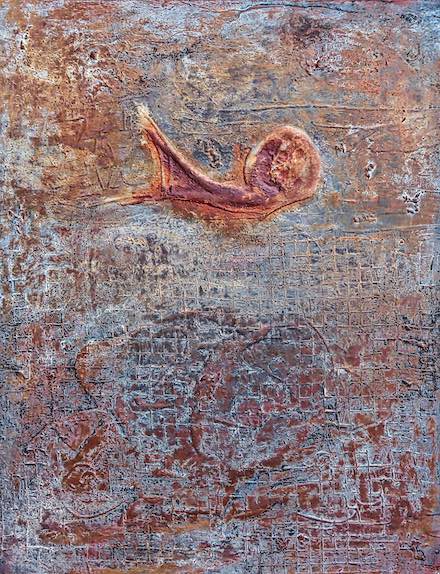
|
|
|
|
|
| Issue 16: | 1 Jan. 2023 |
| Essay: | 2,109 words |
| Footnotes: | 136 words |
| Visual Art: | Paintings |
Essay & Paintings by Kendall Johnson
From a series on self-care for writers
Writing to Heal, Part 1: Tapping Hidden Gifts of Experience

Untitled (Vietnam Series #13), 2016 © by Kendall Johnson
Courtesy of Sasse Museum of Art
I found I’d been left in a field of bones. Many bones
lay about and were dry.... I breathed upon them,
and the breath came into them and they stood.
—Adapted from Ezekiel 37:1-10 1
Everyone has their own Ground Zero moments—great pain, sudden loss, betrayal, disillusionment, or violence—when it feels like your very neural circuitry was fried. Some memories of these are in flashing neon, while others lay deeply submerged.
As writers and artists, we are unique in our capacity to tap those memories as rich resources, gifts of experience to enliven our work and connect us to our audience. Yet there are risks. This is the first of three conversations about mining this treasure, carefully. I’ll start with some of my own extremes.
I’ve been broken by the world, I’ll admit. Stronger now at some of my broken places, yet scarred in many ways. After growing up the child of a war vet who brought the Remagen bridge and the liberation of death camps back home with him in 1946, I followed the toxic dictums of family and culture, the rigid definition of masculine adequacy based upon violence and achievement; first into wildland firefighting, then into Vietnam. Upon return I spent a half-century in search of redemption. As teacher, trauma therapist, and on-scene crisis-management consultant, my icon—my guiding hope—has been this image: a broken ceramic bowl with the parts glued back together, the scars and seams shining with resin and gold.2 Writing and art have been my salvation.
Writing 9/11: Triggers
After 9/11, as the saying goes, everything changed. For me it meant working for several years as trainer, consultant, and therapist for crisis teams in Lower Manhattan, mostly in schools. The crisis teams were my people—school psychologists, counselors, teachers, and support staff I had trained over the previous decade to help schools handle emergencies. I also spent time in FEMA headquarters, firehouses, hospitals, body identification centers, and on the street.
Excerpted from my flash memoir Black Box Poetics:
Phyll had stopped early at the District Office to pick up some reports, when word came down that a passenger plane had flown into the first tower in the World Trade Center. She stopped in to the office of the director of student services, who was the head of the crisis team, and was told to help call the other team members. While all of the team planning had the members working in groups of three to six, only twenty members had made it to their schools before traffic became gridlocked. One, only, could be spared for each of the closest schools.
She relayed instructions from her team leader to the others: stay with your school, work in teams of one, do what you can with whatever situation you find. Her school, a specialty high school in the finance district, stood within a block of the Trade Center. She drove in as close as she could get, then left her car and walked across Wall Street into the smoke and concrete dust.3
We hadn’t anticipated anything of this size, this personal. Four of my team’s schools were evacuated through falling bodies and burning debris. Although trained to work in teams, twenty of our people had to work alone that day. And twenty-one schools were immediately impacted.
My journal entry from October, 2001, Lower Manhattan:
Ground Zero; the still standing skeletal structure, the bones, the perspective, the mood, the chaos ... the pit at the center of the city. When I look at pictures of it, I get visual and olfactory flashbacks. The subway door opening and the smell of burnt bodies and wiring rolling in, fires still burning, the clamor of sirens and big equipment working, the police and National Guard barriers, the memorials, the vacant stares. Faces of people gone, posted on billboards like so many lost cats. People say, “I don’t want to talk about it.” Then they start telling me stories. Sooner or later they would get around to “the burning image” that stuck in their minds. After they get through that, they would run up against the “what if it never gets better” question. How do I get out of here? How can I make it quit? They look at me and wait for answers.
Another entry, following a debriefing with my team in October, 2001, in a basement near Ground Zero:
I asked them: what did you see that morning, on 9/11?
Their most frequent quotes: “terrible things” “everything surreal” “bodies falling” “children stepping over bodies” “smell was terrible” “couldn’t find the students” “smoke and dust everywhere” “couldn’t see” “kids crying” “couldn’t believe how teachers still functioned” “didn’t know what to say or do” “noise was unbelievable.”
The long hours and distress of absorbing hundreds of horrific stories went on for several years. You might wonder how I coped with my teaching job and private practice in California, only to jump on a plane to New York and spend days with frantic people in dreadful circumstance. My self-care plan followed all the admonitions I give to my trainees: I saw the shrinks, the priests, and spent time with my closest friends. I exercised, ate reasonably, and didn’t drink any more than usual. All of that helped.

Untitled (Vietnam Series #7), 2014 © by Kendall Johnson
Courtesy of Sasse Museum of Art
What helped the most, though, what allowed me to explore the labyrinthine tangle of amnesic fog banks, red-hot memories, and frozen futures, was my writing and painting. Stolen moments in my studio allowed me to sort things out over an extended period, to lay out tangles of interlocking dimensions of a personal past I hadn’t figured out yet, a present which felt like towers of layered jello all a-quiver, and a future obscured by war and terror. I was a mess, but writing it out in poems, stories, plays, and song helped me hold onto the hope that some sort of order was coming.
Rumors of War: Erasure
During that period I wrote madly. Some of the expressive writing was eventually publishable, following years of revision; most was not. But it got me through a rough stretch, and some of the writing has taken me the intervening 15 or so years to salvage. Interestingly, only a little was directly about 9/11.
For years I’d also been doing intense abstract painting, not understanding why or of what. Slowly I began to see the painting I’d been doing all along in an entirely different light. I came to see the abstraction as symptomatic of someone who was suffering from amnesia and dissociation. While I couldn’t remember many details of Vietnam, I remembered the intensity. And I had been painting the feelings, not the events.
The real question was, how to deal with my own psychological aftermath. 9/11 threw me back into Vietnam, on a gunboat on firing missions above the DMZ. And further back to my wild and dangerous days as a wildland firefighter. I was even propelled back into a myriad of murky family-of-origin issues of abuse and loneliness. I could find my way through the days; it was the long nights that were the hardest. Things I hadn’t been able to remember were starting to make themselves known. Lost selves were emerging.
Journal entry from a workshop in Cambria, California, 2005:
I’m up early to try out an exercise we learned the day before. Mostly therapists who do art, we are learning how to help our clients access memories and perspectives that seem locked up inside. While the others catch a last hour of sleep or early breakfasts by the sea, I take advantage of the workshop leader’s offer to use the conference room to practice. The room is cold, fog outside the window. I turn on a CD, go through the ritual of music, stretching, and then drawing. I close my eyes and let my inchoate thoughts wander. As we were taught the day before, I clear my mind, focus on the haunting choral piece, and let my body speak through black charcoal onto the large paper. As the workshop leader had suggested, I use my non-dominant hand. I scarcely notice what is emerging. Fifteen minutes later I break my reverie and stand back. On the white background is a design that takes me back to July, 1967. A round circle floats in white space, lines stretching off, down to the left and diagonally above.
I sit down and study this emergent, abstract shape. After a few minutes it comes to me. A head attached to a shriveled floating body, with jutting lines lifting up. A head, attached to a floating body, with intravenous tubes going in and drain tubes going out. I am transported back to a medical evacuation from Vietnam thirty years prior, where for sixteen hours, through a haze of drugs, I was forced to watch flight nurses struggle to keep twenty marines alive. During those long hours several lost that fight.
The combination of music, movement, and non-dominant hand drawing allowed me access to hidden memories my mind had locked tightly away. For the next six months I reassessed a set of abstract paintings which had been produced over a ten-year period. I came to understand that these abstracts are paintings of the truth, if not the facts, of my combat experiences long ago. The flashbacks triggered by 9/11 were more explicit memories of the earlier times. They served as “flashbulb” snapshots, scenes frozen in time, of moments of panic, rage, or near-hysteria experienced long ago. These memories, because of the different brain chemistry designed to help us cope with emergency, are laid down differently than normal memories. They don’t play well with other memories, and can lurk out of sight.
In particular, I worked like a rat terrier, trying to find more in the workshop-produced design of the off-center circle with diagonal lines coming in and out. In the end I produced the painting Embryonic (2006), along with a set of other paintings that formed a collection with the rudimentary flash-memoir vignettes. These formed my book Fragments: An Archeology of Memory.4

Embryonic (2006) © by Kendall Johnson
Courtesy of Sasse Museum of Art
On Going Deep
Little did I know while I was gathering fragments that I was setting the stage for going deeper in my writing, seeking an overarching narrative to pull those pieces together. Finding that narrative is about, for me, sorting and making sense of the disparate welter of experiences I’ve accumulated. Michael Loveday, in his craft book on developing the Novella-in-Flash, asks the question: “Are we moments or story?”5 Do our lives consist of a clear narrative arc, beginning with a complication and ending with resolution? Based upon my personal (perhaps not-too-representative) experience, I would argue that our Ground Zero moments usually lack an overarching arc. That arcing web of meaning, if we are fortunate (despite our attempts to impose one through our arbitrary beliefs and suppositions), only reveals itself toward the end.
As writers and human beings, we spend most of our reflective time attempting to discern that arc of meaning. I’ve been lucky in that my work has given me flashes of clarity. From the muddle that was New York in 2001, I’ve been able to pull out some direction.
Writing can heal. It shares that magic with painting, movement, and music, and it pulls from us layers that we can access, sometimes in no other way. Yet it’s a two-way street; just as the creative process can pull from you things that you cannot otherwise put to words, so can it call those memories and feelings and insights that you think you have safely locked away and forgotten, into a form that allows you to share your truth with others. And with yourself.
Write your truth. Write to heal; heal to write. Understand that the path to your personal truth involves surprises that you may not anticipate, and reactions that block your journey. In Part II of this series, I’ll share some of the mechanics of triggers, erasures, and overreaction, and ways I’ve found to manage and even utilize them to support the writing process. I will provide both concepts and exercises for you.*
Until then, be safe in there.
Reference Notes:
- The Holy Bible, New International Version (Zondervan; USA: 2011).
- Kintsugi, aka golden repair, is the Japanese art of mending broken pottery with lacquer that’s dusted or mixed with powdered gold or silver. Highlighting imperfections and celebrating breakage as part of life’s journey, repaired areas may signify synthesis and rebirth. Wikipedia: https://en.wikipedia.org/wiki/Kintsugi
See also “Object Lesson: Kintsugi reflects beauty in flaws, strength in healing” at New Orleans Museum of Art (NOMA: 9 November 2020). - Johnson, Kendall. Black Box Poetics (Bamboo Dart Press: 2021).
- Johnson, Kendall. Fragments: An Archeology of Memory (Sasse Museum of Art; Upland, California: 2017).
- Michael Loveday. Unlocking the Novella-in-Flash: from blank page to finished manuscript (Ad Hoc Fiction: 2022).
See also Kendall Johnson’s review of Loveday’s book in Issue 14 of MacQ: “Linking Sacred Moments”
* Publisher’s Notes:
Part 2 of this series will appear in Issue 17 of MacQ at the end of January 2023, and Part 3 is scheduled to appear in Issue 18 on the first of May.
This issue, 16, also includes Dr. Johnson’s interview with John and Ann Brantingham, authors of Kitkitdizzi: A Non-Linear Memoir of the High Sierras, an interview in which they discuss, among other things, how they find personal balance and how they best care for themselves and each other.
Kendall Johnson
grew up in the lemon groves in Southern California, raised by assorted coyotes and bobcats. A former firefighter with military experience, he served as traumatic stress therapist and crisis consultant—often in the field. A nationally certified teacher, he taught art and writing, served as a gallery director, and still serves on the board of the Sasse Museum of Art, for whom he authored the museum books Fragments: An Archeology of Memory (2017), an attempt to use art and writing to retrieve lost memories of combat, and Dear Vincent: A Psychologist Turned Artist Writes Back to Van Gogh (2020). He holds national board certification as an art teacher for adolescent to young adults.
Recently, Dr. Johnson retired from teaching and clinical work to pursue painting, photography, and writing full time. In that capacity he has written five literary books of artwork and poetry, and one in art history. His shorter work has appeared in Literary Hub, Chiron Review, Shark Reef, Cultural Weekly, and Quarks Ediciones Digitales, and was translated into Chinese by Poetry Hall: A Chinese and English Bi-Lingual Journal. His memoir collection, Chaos & Ash, was released from Pelekinesis in 2020, his Black Box Poetics from Bamboo Dart Press in 2021, The Stardust Mirage from Cholla Needles Press in 2022, and his Fireflies Against Darkness and More Fireflies series from Arroyo Seco Press in 2021 and 2022. He serves as contributing editor for the Journal of Radical Wonder.
Author’s website: www.layeredmeaning.com
More on the Web: By, About, and Beyond
⚡ Kendall Johnson’s Black Box Poetics is out today on Bamboo Dart Press, an interview by Dennis Callaci in Shrimper Records blog (10 June 2021)
⚡ Self Portraits: A Review of Kendall Johnson’s Dear Vincent, by Trevor Losh-Johnson in The Ekphrastic Review (6 March 2020)
⚡ On the Ground Fighting a New American Wildfire by Kendall Johnson at Literary Hub (12 August 2020), a selection from his memoir collection Chaos & Ash (Pelekinesis, 2020)
⚡ A review of Chaos & Ash by John Brantingham in Tears in the Fence (2 January 2021)
| Copyright © 2019-2025 by MacQueen’s Quinterly and by those whose works appear here. | |
| Logo and website designed and built by Clare MacQueen; copyrighted © 2019-2025. | |
|
Data collection, storage, assimilation, or interpretation of this publication, in whole or in part, for the purpose of AI training are expressly forbidden, no exceptions. |
At MacQ, we take your privacy seriously. We do not collect, sell, rent, or exchange your name and email address, or any other information about you, to third parties for marketing purposes. When you contact us, we will use your name and email address only in order to respond to your questions, comments, etc.